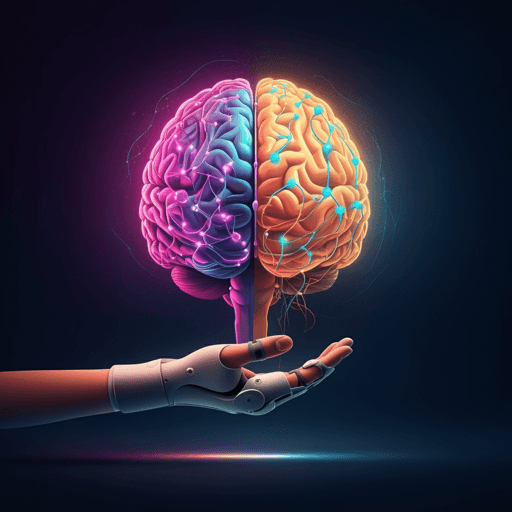
Medicine and Health
The ReHand-BCI trial: a randomized controlled trial of a brain-computer interface for upper extremity stroke neurorehabilitation
J. Cantillo-negrete, M. E. Rodríguez-garcía, et al.
A randomized trial of the ReHand-BCI—using a closed-loop robotic hand orthosis—showed meaningful upper-extremity gains and neuroplastic trends in stroke patients, with the experimental group improving on functional arm tests and showing ipsilesional cortical activity trends. Research was conducted by the authors listed in the Authors tag.
~3 min • Beginner • English
Introduction
Stroke is a leading cause of disability worldwide, with upper extremity hemiparesis severely limiting activities of daily living. Conventional rehabilitation leaves many patients with persistent deficits, prompting evaluation of adjunctive technologies such as FES, robotics, rTMS, and BCI. BCIs decode motor intention from CNS signals (typically EEG) to drive external devices and may foster neuroplasticity via closed-loop feedback. Prior trials of BCI with robotic feedback show promising clinical outcomes, but the mechanisms of recovery and differential effects compared with robotic therapy without BCI remain underexplored. This study tests the hypothesis that a BCI-controlled robotic hand orthosis (ReHand-BCI) would yield greater upper extremity functional recovery, more ipsilesional cortical activity, higher ipsilesional CST integrity, and greater CST excitability than a sham-BCI intervention with random orthosis activation.
Literature Review
Meta-analyses and controlled trials have supported BCI-based rehabilitation as beneficial but emphasized the need for more rigorous clinical evidence and mechanistic understanding (Cervera et al., López-Larraz et al., Mansour et al., Zhang et al.). fMRI provides insights into motor network reorganization post-stroke, yet few BCI trials have comprehensively paired clinical outcomes with multimodal neurophysiology (EEG, fMRI, DTI, TMS). Ramos-Murguialday et al. demonstrated benefits of BCI with robotic feedback compared to sham, including fMRI changes, but evidence remains limited, especially in severely impaired patients. Reviews suggest that differences between BCI+robot vs robot-alone may be modest and sample-size dependent, with both modalities potentially improving function.
Methodology
Design: Single-center, triple-blinded randomized controlled clinical trial (block randomization, 1:1 allocation), approved by institutional ethics (25/19 AC), registered on ClinicalTrials.gov (NCT04724824). Blinding encompassed therapists, outcome assessors/statisticians, and participants. Planned sample: 15 per group; achieved: EG n=10, CG n=9 in final analysis. Participants: Adults >18 years with first ischemic or hemorrhagic stroke (3–24 months post-onset), right-handed premorbidly, hand paresis (Motricity Index 0–22), mild or less cognitive deficits, normal/ corrected vision; exclusions included severe spasticity (MAS>2), severe aphasia/depression/attention deficits, incompatible implants, confounding medications; elimination criteria included withdrawal, poor adherence (<80% sessions), missing outcome visit, EEG artifacts/epilepsy. Intervention: 30 sessions over 6 weeks (5/week), each session 80 trials (4 runs of 20). Trial structure: 0–4 s rest (white cross), beep at 3 s, 4–9 s motor intention (MI) period signaled by arrow (1.5 s arrow, then black screen 3.5 s); 9–14 s orthosis extension if flexion occurred; 14–18–20 s random blue relax. EG: robotic hand orthosis (25% max displacement ≈1.38 cm) activated contingent on online EEG classification of MI during MI period (up to four flexions per trial). CG: orthosis activation randomly during MI period (probability 55–85% per run), independent of MI. Feedback performance faces displayed at run end. ReHand-BCI system: EEG acquisition with 16 active electrodes (10–10 positions over motor areas), g.USBamp amplifier at 256 Hz; offline calibration using filter bank (8–12 to 28–32 Hz), CSP feature extraction, PSO feature selection, LDA classifier; online classification of 1-s windows as MI vs rest; Bluetooth-connected robotic hand orthosis. Outcomes: Primary—FMA-UE and ARAT. Secondary—EEG laterality coefficient (LC, alpha and beta bands) during unaffected hand movement and affected hand MI; fMRI laterality index (LI) using GLM-derived z-values within motor ROIs; DTI ratio of fractional anisotropy (rFA) for CST (ipsilesional/contralesional); TMS motor-evoked potentials (MEPs) assessing CST excitability/integrity at 100%, 120%, 140% of resting motor threshold (RMT). Assessment schedule: T0 (baseline), T1 (after 15 sessions), T2 (end of intervention), T3 (6 months post-baseline). Between T0–T2, upper limb conventional therapy was restricted; lower limb/language therapies allowed; no restrictions T2–T3. EEG LC processing: 32-channel EEG; preprocessing with FIR high/low/notch filters, ICA artifact removal, common average reference; wavelet-based time-frequency; ERD/ERS calculation with bootstrapping; sERD summed over bilateral motor-region channel pairs to compute LC (ipsilesional vs contralesional desynchronization). fMRI LI: 3T Philips Ingenia; block-design motor tasks; preprocessing and GLM in FSL; ROIs included pre/postcentral gyri, SMA, Rolandic operculum, putamen, globus pallidus, thalamus, cerebellum; LI computed from summed positive z-values in ipsilesional vs contralesional masks. DTI rFA: eddy/motion correction; FA maps; CST masks from JHU ICBM-DTI-81 atlas; rFA=mean FA ipsilesional CST/mean FA contralesional CST. TMS: figure-of-eight coil; cortical mapping; adaptive RMT estimation; 30 MEPs at each intensity per hemisphere; peak-to-peak amplitude quantification. BCI performance: classification accuracy of 1-s windows as MI vs rest, averaged across sessions. Statistics: Normality by Lilliefors; nonparametric tests (Mann-Whitney U for intergroup; Friedman with Bonferroni post-hoc for intragroup); effect sizes (Pearson r for U; Kendall’s W for Friedman). BCI accuracy compared by two-sample t-test with Hedges-corrected Cohen’s d. TMS descriptive analyses due to missing measurable MEPs in some hemispheres/sessions.
Key Findings
Participants: 45 screened; 23 randomized (EG 12, CG 11); final analysis EG 10, CG 9 (two EG excluded due to MRI technical issues; one CG withdrew). No adverse events. Primary outcomes: FMA-UE—significant within-group improvements. EG: Friedman p<0.001, W=0.629; post-hoc T0 (24.5 [20,36]) vs T2 (28 [23,43]) p=0.011; T0 vs T3 (29 [25,44]) p=0.001. CG: p=0.001, W=0.597; T0 (26 [16,37.5]) vs T2 (34 [17.3,46.5]) p=0.008; T0 vs T3 (32 [16.8,52]) p=0.003. Intergroup comparisons at each timepoint were not significant (small effect sizes). Mean post-treatment change: EG 4.5 ± 2.6; CG 6.2 ± 4.1, within reported MCID (~5.25). ARAT—EG significant improvements: p=0.001, W=0.547; T0 (8.5 [5,26]) vs T2 (20 [7,36]) p=0.034; T0 vs T3 (15 [2.5,40.8]) p=0.002. CG: p=0.011, W=0.416; only T0 (3 [1.8,30.5]) vs T3 (22 [2.5,47.3]) p=0.037. Intergroup differences not significant. Post-treatment changes: EG 8.4 ± 7.6; CG 7.0 ± 8.9 (both ≥ MCID 5.7). Secondary outcomes: No significant intergroup differences in LC (alpha/beta, affected MI or unaffected movement), LI (affected MI or unaffected movement), or rFA at any timepoint (effect sizes small–medium). EG rFA intragroup: p=0.045, W=0.268, but no post-hoc differences after correction; tendency toward higher median rFA (greater ipsilesional CST integrity) across intervention. TMS: Measurable ipsilesional MEPs at T0 in 5 EG and 6 CG; T2 same; T3 4 EG and 4 CG. Median MEPs >50 µV; amplitudes increased with higher stimulation intensity. Ipsilesional hemisphere MEP distributions at 120% and 140% RMT were higher in EG than CG at T2 and T3, suggesting greater excitability/integrity in EG. Contralesional hemisphere showed higher 140% RMT amplitudes in EG at T2, while CG had lowest at T2. BCI performance: EG 67.3% ± 8.97% vs CG 69.28% ± 4.1%; p=0.557; d=−0.263 (similar feedback exposure). Follow-up (≈18 weeks post-intervention end): gains diminished relative to post-treatment, with some decline, indicating therapy-induced changes rather than spontaneous recovery.
Discussion
Both BCI and sham-BCI interventions produced clinically meaningful improvements in upper extremity sensorimotor function (FMA-UE) and functional performance (ARAT), despite severely impaired baseline status. Functional gains (ARAT) appeared earlier and more robust in the BCI group by post-treatment, consistent with task-specific training emphasizing grasping. Multimodal physiological measures showed converging trends—greater ipsilesional cortical activity (EEG LC), higher ipsilesional CST integrity (DTI rFA), and sustained ipsilesional CST excitability (TMS MEPs)—for the BCI group, although not statistically different from controls, likely due to limited power. These patterns support the mechanistic hypothesis that closed-loop BCI fosters ipsilesional neuroplasticity related to motor recovery. The similarity in BCI vs sham clinical outcomes aligns with prior meta-analytic observations that both robotic feedback and BCI+robot can enhance function, with differential effects potentially modest and sample-size sensitive. Sustained corticospinal excitability and trends toward ipsilesional structural remodeling indicate that BCI may yield longer-lasting physiological changes than sham. The comprehensive, multimodal assessment over 30 sessions and long follow-up adds novel insight into how closed-loop feedback may shape both functional and structural recovery trajectories.
Conclusion
This triple-blinded randomized trial evaluated a broad spectrum of clinical and neurophysiological outcomes over a 30-session BCI intervention using ReHand-BCI versus sham-BCI in stroke survivors with severe upper limb impairment. Both groups achieved clinically meaningful improvements; BCI showed earlier and stronger functional gains and trends toward enhanced ipsilesional cortical activity and CST integrity/excitability. While primary intergroup differences were not statistically significant, findings suggest closed-loop BCI can promote neuroplastic changes beyond sham. Future research should employ larger, stratified samples (by lesion type, stage, impairment severity), potentially adjust therapy intensity to patient characteristics, and analyze session-by-session dynamics to clarify which subgroups benefit most and delineate mechanisms.
Limitations
The study was underpowered due to limited sample size (funding constraints halted recruitment before the planned n=30), likely obscuring intergroup differences. Heterogeneity in lesion location (cortical, subcortical, mixed) and stroke stage (late subacute vs chronic) may have introduced variability. Approximately half of participants lacked measurable ipsilesional MEPs at some timepoints, limiting TMS analyses. Follow-up occurred without restrictions on conventional therapy, potentially confounding long-term effects. Single-center design may limit generalizability. The sham intervention’s random activation probabilities yielded feedback exposure comparable to BCI performance, potentially diluting detectable differences.
Related Publications
Explore these studies to deepen your understanding of the subject.







